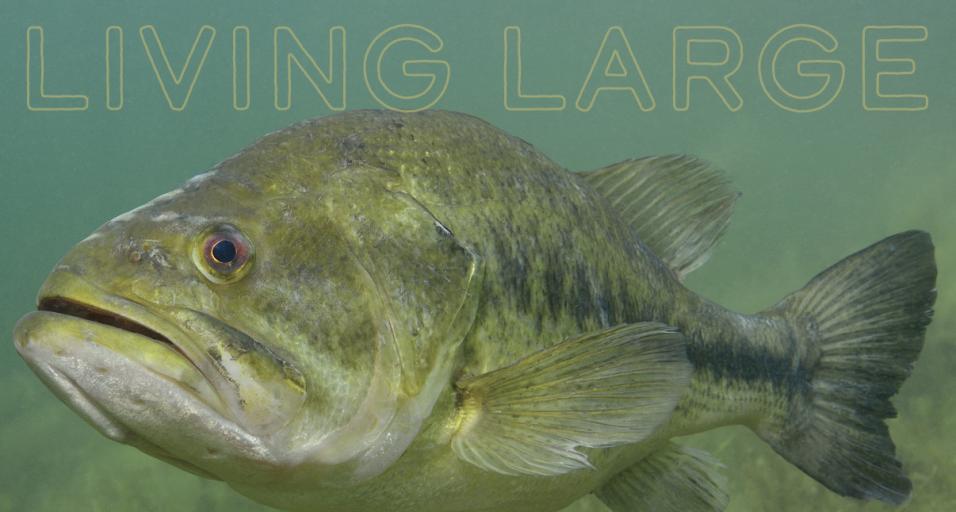Wyoming offers a lot of angling diversity. Several species of trout swim in the state's many lakes and streams. There are walleye in many reservoirs, and kokanee salmon continue to grow in popularity among anglers. But what about largemouth bass?
It's too cold in Wyoming for largemouths, some might say.
They'd be wrong.
While Wyoming won't ever be a hotbed for largemouth bass like Florida, Georgia or Texas, the Cowboy State does have some quality largemouth bass fisheries.
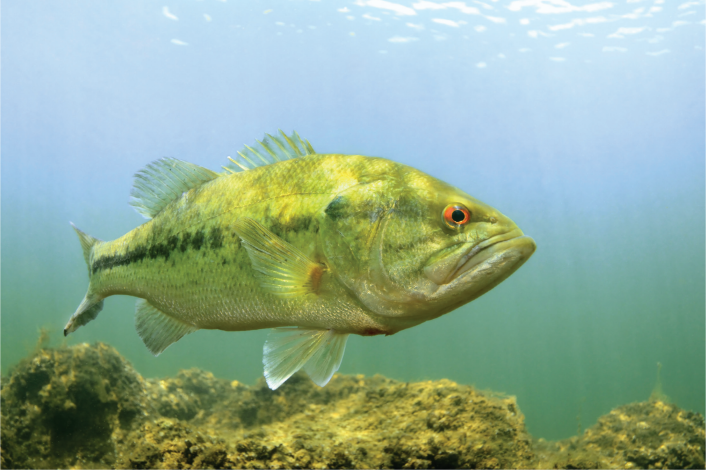
"If people are watching bass fishing shows and seeing anglers consistently pull out bass upwards of 8 pounds, that's not what Wyoming is going to provide," said Chance Kirkeeng, Wyoming Game and Fish Department Fisheries biologist in the Laramie Region. "But there are opportunities for anglers in Wyoming to catch a largemouth bass that's 3-5 pounds. These fish are super aggressive and really put up a fight. In many of the waters they are in, there is a chance to catch other unique species such as crappie, bluegill and catfish. If that is considered good by anglers, then we have it in selected areas of the state."
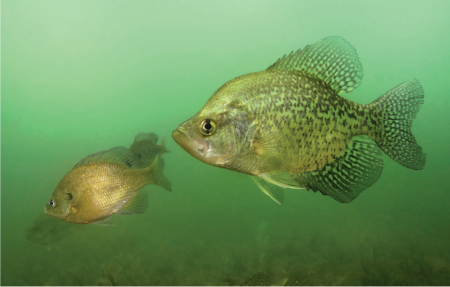
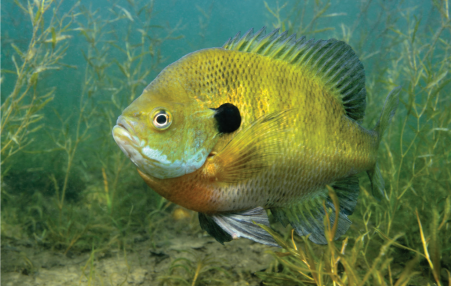
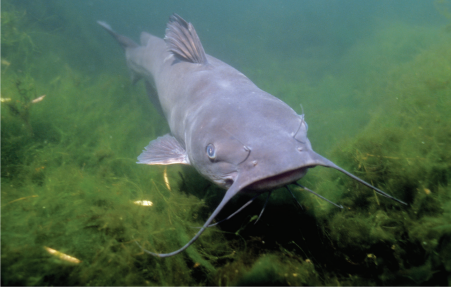
WHERE TO GO
The aptly named Bass Lake, also known as Lake Cameahwait about 15 miles west of Shoshoni, is a good place to start.
“What makes Cameahwait a good fishery for bass is it offers the opportunity to catch some bigger fish,” said Jake Ruthven, Game and Fish fisheries biologist in the Lander Region. “Anglers are most likely to catch a fair number of fish in the 10-18 inch range, though there is also a chance to catch fish over 20 inches.”
Bluegills were first stocked in Cameahwait in 2012 and provide a forage base for bass. The lake is managed to protect fish 10-15 inches long; the daily creel limit at this lake is two largemouth bass with only one exceeding 15 inches.
Two of the state’s better largemouth bass lakes are in Wyoming’s largest city. Sloans Lake and Lake Absarraca in Cheyenne are community fisheries. Rock Lake near Wheatland and Packers Lake south of Torrington are two other largemouth bass fisheries that Kirkeeng said — along with the two in Cheyenne — are dubbed as the “big four” in the Laramie Region.
“These are the places we point anglers to that produce nice-sized fish,” Kirkeeng said.
The state-record largemouth bass was caught out of Kleenburn Ponds north of Sheridan in 2018. The fish weighed 11.51 pounds and broke the previous record by nearly four pounds.
“We have the advantage of topography in our region. We’re the lowest-elevation part of the state, and that translates into longer growing seasons,” said Paul Mavrakis, Game and Fish fisheries supervisor in the Sheridan Region.
“We’re on the fringe of those warm/cool-water fish to be able to grow for a longer period of time. We probably have one of the longer growing seasons in Wyoming. We’re able to grow bigger bass than some of the other places in Wyoming.”
Mavrakis added bass fishing is popular where there are good bass fisheries in his region, which include in and around the towns of Sheridan, Buffalo and Newcastle.
ALL-TIME RECORD
When Caleb Salzman caught Wyoming’s largest largemouth bass in 2018 he likely put his name in the record books forever.
Salzman was a freshman at Sheridan College when he landed an 11.51-pound fish from Kleenburn Ponds north of Sheridan. The bass was 24.5 inches long with a 20.75-inch girth. Wyoming’s record largemouth bass is bigger than the state records in Colorado, Kansas and Nebraska.
In a news release from the Wyoming Game and Fish Department in 2018, Salzman wasn’t able to get an official weight of the bass until the morning after he caught it. Salzman said in the news release the bass weighed 12.5 pounds on a cheap scale from a tackle box not long after he landed it.
The previous record was held by Dustin Shorma at 7.87 pounds. Shorma, the Wyoming Game and Fish Department wildlife supervisor in the Sheridan Region, set the record in 1992 as a 15-year-old. He held the record for 26 years. Prior to Shorma’s record fish, the biggest largemouth bass caught in Wyoming was a 7.13-pounder in 1942 out of Stove Lake in Goshen County.
“I think that the current record is there to stay,” Shorma said. “It is up there with our brook and golden trout records.”
The state-record brook trout of 9 pounds, 11 ounces was caught in 1976, and the golden trout record — which also is the world record — of 11 pounds, 4 ounces was caught in 1948. Both fish were caught in lakes in Sublette County.
HOW TO CATCH LARGEMOUTH BASS
Many methods anglers use to catch largemouth bass where they are popular and abundant — like in the Midwest and South — work in Wyoming.
Finesse techniques such as swim baits, crankbaits, a plastic worm and a dropper — known as a Texas rig — are effective baits.
"With this kind of finesse fishing you are trying to trick fish into attacking the bait," said Chance Kirkeeng, Wyoming Game and Fish Department Fisheries biologist in the Laramie Region.
Kirkeeng added in other parts of the country fly-fishing for largemouth bass is becoming more popular.
"I haven't seen a lot of anglers fly-fish for bass in the Laramie Region, but for folks who like fly angling it doesn't just have to be about trout. A 14-inch bass pulling on a fly rod is a heck of a lot of fun."
KEYS TO GROWTH
Like any fish, largemouth bass need food and the right habitat to grow and survive. But in Wyoming they also need time.
Kirkeeng said research in the big four lakes in the Laramie Region showed it took six years for largemouth bass in Rock Lake to reach 15 inches long, and 10 years at the other three. Kirkeeng added that in areas like the Midwest and South, it takes an average of six to seven years for largemouth bass to grow to 18 inches.
Kirkeeng said there are two life history strategies for largemouth bass: fast-growing, young-dying and slow-growing, old-dying. Wyoming doesn’t grow bass at fast rates, so the best strategy is slow-growing, old-dying.
“Longevity is a pretty important characteristic of the genetics that is important for Wyoming bass,” said Kirkeeng.
It was estimated that the state-record bass caught in the Sheridan Region in 2018 was 17 to 19 years old. Largemouth bass also can be their own worst enemy.
Mavrakis said largemouth bass are “prolific breeders” and they can stunt their own population in a body of water, especially one with limited food, predators and angler harvest. They also will eat each other. Mavrakis added he cautions private landowners interested in creating bass ponds.
“There’s only so many groceries in those kinds of waters,” he said. “With no constant harvest from anglers and/or predators, those fish get smaller and smaller.”
MANAGEMENT
According to the 2024 Wyoming Game and Fish Department Fishing Regulations, the creel limit on largemouth and smallmouth bass — in combination — is six. However, not all waters with bass are managed the same.
At Lake Absarraca, Sloans Lake and Packers Lake, all bass 15 inches long or shorter must be released. In Grayrocks Reservoir in Platte County, the limit is three bass per day and only one can exceed 12 inches.
Because largemouth bass reproduce well on their own, Game and Fish does not stock bass on a reg- ular basis. Travis Trimble, Game and Fish assistant fish culture supervisor, said going back to 2015 the request for largemouth bass ranged between 20,000 to 39,000 per year. That was requested and doesn’t mean that’s how many were stocked.
Largemouth bass was one of many cool/warm-water fish species Wyoming would bring in from other states for stocking. However, the availability of bass and risk of aquatic invasive species entering Wyoming from those imported fish resulted in no stocking of bass from an out-of-state source in about seven years.
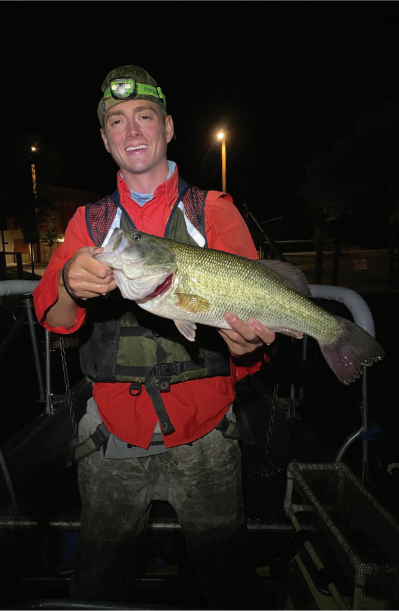
However, there have been instances where Game and Fish used largemouth bass from Wyoming waters to start or enhance other largemouth fisheries in the state. Renner Reservoir in the Cody Region is currently the primary source for largemouth bass in the state. Healy Reservoir in the Sheridan Region also has been a source in the past, along with Bass Lake.
Last year, Game and Fish announced plans to construct a cool/warm-water fish facility at the Dan Speas Fish Hatchery near Casper to raise these fish to stock in Wyoming. Walleye are the primary cool/ warm-water fish in high demand in the state, but that doesn’t mean others can’t be raised.
More importantly, that facility will provide a safer environment to raise those fish.
“Department opportunities to obtain fish from other states continue to dwindle,” Trimble said.
“The states we work with do a great job sampling and testing for AIS and fish pathogens. Every time they detect an AIS or a pathogen, Game and Fish loses another source of cool/warm-water fish for Wyoming’s anglers. It is likely only a matter of time before AIS shows up at the out-of-state hatcheries we work with.
“Down the road, the cool/warm-water facility will be beneficial to Wyoming. We will get the processes for raising these fish figured out and will be more self-reliant.”
THE FUTURE
Dustin Shorma has a good sense of largemouth bass fishing in Wyoming. The Sheridan Region Wild- life Supervisor and former game warden has been around many waters in northeast Wyoming that can grow good-sized bass. Shorma held the state largemouth bass record prior to it being broken in 2018. He set the record in March 1992 as a teenager.
“I’d definitely call it a niche-type fishery,” said Shorma, who added there is a good mix of public and private waters in the Sheridan Region with largemouth bass. “There just aren’t a lot of places in the state to catch largemouth bass. I think people have figured out we have them here, and in those places where we have them people target them. I think it’s a function of availability.”
Mavrakis said he’s seen largemouth bass fishing evolve over the years. He said Healy Reservoir didn’t have largemouth bass 20 years ago. Today it has a solid population and anglers target them.
“If there are fisheries with good populations, people will come and they will find those waters,” Mavrakis said.
— Robert Gagliardi is the associate editor of Wyoming Wildlife.

